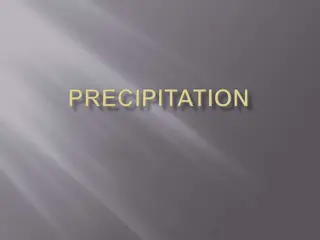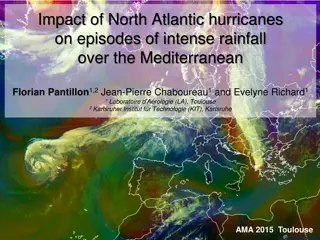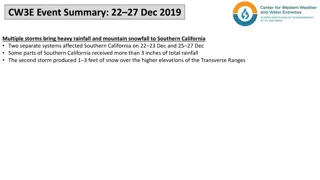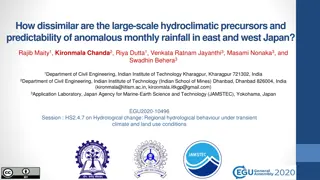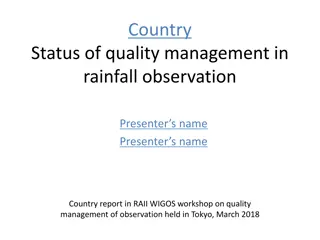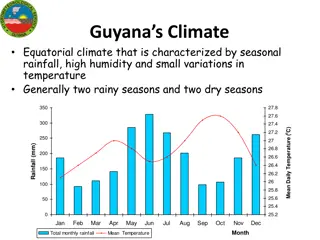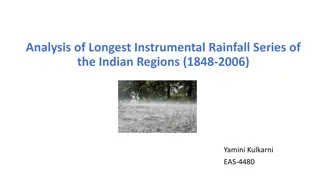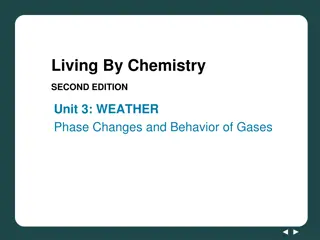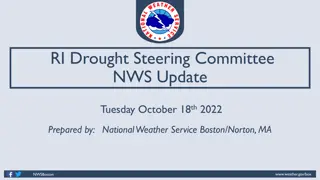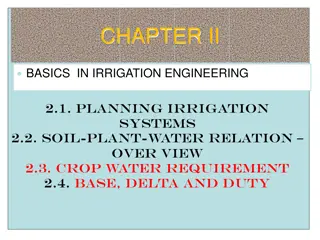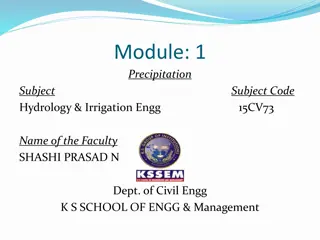Understanding Precipitation and Rainfall Patterns in Hydrology
Exploring the various forms of precipitation like rainfall, snowfall, hail, and sleet, this lesson delves into the complexities of precipitation forms, intensity classifications, types of rain gauges, and methods for correcting deficiencies in rainfall data. Through detailed descriptions and images, you'll grasp the significance of precipitation in hydrology studies.
Download Presentation

Please find below an Image/Link to download the presentation.
The content on the website is provided AS IS for your information and personal use only. It may not be sold, licensed, or shared on other websites without obtaining consent from the author. Download presentation by click this link. If you encounter any issues during the download, it is possible that the publisher has removed the file from their server.
E N D
Presentation Transcript
G205 (hydrology) First Semester Lesson Two
The term precipitation denotes all forms of water that reach the earth from the atmosphere. Rainfall Snowfall Hail Frost dew
Precipitation Forms Snow is complex ice crystals. The average water content of snow is assumed to be about 10% of an equal volume of water. Hailstones are balls of ice that are about 5 to over 125 mm in diameter. Their specific gravity is about 0.7 to 0.9. Thus, hailstones have the potential for agricultural and other property damage
Precipitation Forms Sleet results from the freezing of raindrops and is usually a combination of snow and rain Rain liquid water drops of a size 0.5 mm to about 7 mm in diameter. Drizzle small water drops less than 0.5 mm in diameter. The settling velocity is slow, with the intensity rarely exceeding 1 mm/hr (0.04 in./hr).
Types of rain gauges Non-recording
Types of rain gauges Recording Tipping bucket Weighing bucket Floating or Natural Syphon
Rainy days When the rainfall during a day is 2.5 mm or more the day is known as rainy day. Classification of intensity of rainfall The rainfall intensity is classified as follows: 1. Up to 2.5 mm/h : light rain 2. 2.5 7.5 mm/h : medium rain 3. 7.5 mm/h and above : heavy rain
Correction of deficiencies in rainfall data Sometimes there might be breaks or gaps in the rainfall data of some stations. These gaps may be due to the following reasons: Absence of an observer Instruments failure Unapproachable circumstances such as flooding
Correction for the missing rainfall data The missing rainfall data may be supplemented by the following method: Arithmetic average method Normal ratio method Weighted average method
Correction for the missing rainfall data Arithmetic average When the data of a rain gauge station, e.g. A , is missing for a year, consider the adjacent rain gauge stations B, C and D. If the rainfall at these adjacent stations B, C and D is within 10% of the average rainfall of A (less or more), then the simple arithmetic average of these adjacent stations of the year may be considered as the missing rainfall of A for that year where, n = Number of adjacent rain gauge stations PB, PC, PD= Precipitation at B, C and D for the period for which the data is missing at A
Example 1 In a catchment area, daily precipitation was observed by 11 rain gauge stations. On 2 August 2005, the observations indicated that one rain gauge was out of order. The observations taken by the 10 rain gauge stations are as follows: Estimate the missing data at H. solution
Correction for the missing rainfall data Normal ratio method If the rainfall of station A is missing for a year and the variation of the adjacent rain gauge stations B, C and D is more than 10%, then simple principle of linearity is used to evaluate the missing rainfall of A as follows: where, NA = Average of A excluding the missing period NBNC= Average of B and C excluding the missing period PBPC= Precipitation at B and C during the missing period n = number of adjacent rain gauge stations considered For this method, a minimum of three adjacent rain gauge stations are considered.
Example 2 The average annual precipitation at five rain gauge stations in a catchment is as follows: However, the precipitation at station P was not available for the year 1996 because the rain gauge was out of order. The precipitation observed at the other stations for 1996 was as follows: Evaluate the precipitation at P during 1996. solution
Correction for the missing rainfall data Weighted Average Method The station of which the data is missing, e.g. A, is considered as the origin and the adjacent rain gauge stations are considered and their distances from A are calculated or measured on a map. It is assumed that the rainfall variation between these two stations A and B is inversely proportional to the square of the distance between them. Thus, where, r1, r2and r3= the distances from A of the adjacent stations B, C and D PB, PCand PD= the rainfall at the adjacent stations B, C and D for the missing period. This method is also known as United States National Weather Service (USNWS) method.
Example 3 The relative positions of the stations A, B, C and D with respect to X are shown
Example 3 The annual precipitation at X for the year 2005 is missing. The annual precipitation at the remaining four stations for 2005 is as follows: Evaluate the missing precipitation at X for the year 2005. solution The relative positions of the stations A, B, C and D w.r.t. X are : AX = (202+ 252) = 32.01 km BX = (402+ 152) = 42.72 km CX = (302+ 202) = 36.05 km DX = (252+ 152) = 29.15 km
Consistency verification of rainfall data records It may happen that the rainfall recorded by a rain gauge station is doubtful. It then becomes necessary to verify the rainfall record of this station. This is known as verification of consistency of a rain gauge. This may by due to the following reasons: Change in the location of the rain gauge Change in the surroundings, namely, growth of trees, buildings, and so on. Change in the instrument Fault developed in the rain gauge The verification can be done by the double mass curve method.
Double Mass Curve method On a simple graph paper, the mass curve of the precipitation of the doubtful station, e.g. A versus the mass curve of the average precipitation for the remaining rain gauge stations whose data are available for the corresponding period is plotted.
Double Mass Curve method Normally, one should get a straight line through origin if the record at A is correct. If there is inconsistency at A from a particular year, the slope of the straight line may change from that year. It may, therefore, be concluded that the records of A are incorrect from that year and need modification. The slope of the straight line is maintained and extended and the record of A is corrected accordingly. This procedure cannot be applied for studies for storm rainfall or daily rainfall.
Example 4 The average annual precipitation data of six rain gauge stations in a catchment area during 1991 2000 are as follows: The data observed at station C were doubtful because of some topographical changes there. Verify whether the data observed at C is consistent and correct it, if necessary.
solution The mass curve coordinates of precipitation at C and also the combined mass curve coordinates of precipitation at A, B, D, E and F will be as follows:
Average depth of precipitation The precipitation over a catchment area is never uniform. This becomes quite clear from the figures of the average depth of precipitation of the various rain gauge stations in the catchment area. One of the basic requirements in the study of a catchment area is the average depth of precipitation over the entire catchment. This is also known as equivalent uniform depth of rainfall. The average depth of precipitation can be calculated by the following methods: Arithmetic mean method Thiessen polygon method Isohyetal method
RAIN GAUGE DENSITY RAIN GAUGE DENSITY Rainfall is the most fundamental data used in the hydrological studies and hence a well distributed network of rain gauge stations is essential. The average area of influence of the rain gauge stations is indicated as rain gauge density or network density. The density of rain gauge stations in an area may be decided taking into consideration the following points: Variation in the rainfall in the area. If the area is plain and if there is not much variation in rainfall, the 1) number of rain gauge stations may be small. 2) The nature of study for which rainfall data is required 3) Cost involved in establishing and maintaining the rain gauge stations
Minimum Density of Rain Gauge Stations Minimum Density of Rain Gauge Stations The following criteria are recommended to minimum density of rain gauge: One rain gauge per 520 km2in plain areas. (For area in the path of low pressure systems, denser network is necessary.) One rain gauge per 260 390 km2for area where average elevation of the area above mean sea level is 1000 m and above. One rain gauge per 130 km2in hilly areas with heavy rainfall. (Higher density recommended wherever necessary.)
the following procedure is recommended to calculate the optimum number of rain gauges in a catchment area. n = Number of rain gauge stations existing in an area P1, P2, P3, , Pn= Average rainfall of the n rain gauge stations Now, N = Number of optimum rain gauge stations x = Percentage permissible error in the estimation of average rainfall. Additional rain gauge stations = N n It may be noted that both Cvand x be mentioned as percentages. The additional rain gauge stations may be located in addition to the existing rain gauge stations, so that they all are evenly distributed over the entire catchment area.
Example In a catchment area covering 100 km2, the average annual precipitation observed at five rain gauge stations is as under. Find the number of additional rain gauge stations and also the rain gauge density if the permissible error is 10%. Solution: Since permissible error is 10%, Number of rain gauge stations required = (Cv/10)2= (26.06/10)2 = 6.79 Additional rain gauge stations required = 6.79 5 = 1.79 2 Rain gauge density = 100/7 = 14.30 km2/rain gauge.
Example 5 In a catchment area covering 100 km2, the average annual precipitation observed at five rain gauge stations is as under. Find the number of additional rain gauge stations and also the rain gauge density if the permissible error is 10%. Solution First, we should compute mean ( ) and standard deviation ( ) = 750+1000+900+650+500 = 760 mm 5 ? ?2 ? 1 = = 198.1 Cv= (198.1/760) * 100 = 26.06% 2 2 ?? ? 26.06 10 Additional rain gauge stations required = 7 5 = 2 Rain gauge density = 100/7 = 14.30 km2/rain gauge N = = 6.79 7
Recurrence Interval of a Storm Recurrence Interval of a Storm The number of years within which a given storm may equal or even exceed is known as recurrence interval or return period and normally is denoted by Tr. Suppose the record at a station or over an area is available for n years, then the precipitation data may be arranged in the descending order. The serial number of a specific value of precipitation in the descending order is known as ranking of the storm, e.g. m. Then the return period of that specific value of precipitation, Tr= n/m. This means that this precipitation value or more than this occurs m times in n years. Probability Probability generally denoted by p is reciprocal of the return period, i.e. p = m/n = 1/Tr. Frequency Probability expressed in terms of percentage is frequency, i.e. frequency = p 100 = m/n 100
Example The precipitation in millimeters observed at a rain gauge station for the last 32 years is as follows: 988, 966, 935, 1007, 992, 1050, 975, 920, 1035, 990, 1095, 1015, 986, 927, 1003, 1055, 1135, 955, 1001, 1045, 1090, 997, 1040, 1100, 948, 972, 1012, 950, 1070, 982, 929, 960 Find 1. The return period and frequency of the precipitation of 997 mm 2. The precipitation of return period of 1.33 and its frequency Solution: The precipitation figures in millimeter were arranged in a descending order as follows:
1. The serial order of 997 mm is 16 Therefore, its return period = 32/16 = 2 and its frequency = 1/2 100 = 50%. 2. Return period = 1.33 = n/m = 32/m Therefore, m = 24. The precipitation figure at serial no. 24 is 966 mm and its frequency will be = 24/32 100 = 75%.
Interpretation and quantification of precipitation data To size water transport and storage systems, quantitative data for rainfall events must be provided. These data can be defined in terms of 1. Intensity (rate of rainfall), usually an average value for a given duration. 2. Duration of storm 3. Time distribution of rainfall over the duration of storm 4. Return period 5. Associated depth of rain
Intensity duration relationship The greater the intensity of rainfall, in general the shorter length of time it continues. A formula expressing the connection would be of the type: a + = i t b where i = intensity (mm/h), t = time (h), a and b are locality constants, and for durations greater than two hours c i = nt where c and n are locality constants
Intensity duration frequency relationships Two important stormwater parameters, intensity and duration, can be statistically related to the frequency of occurrence. The graphical representation of this relationship is the intensity-duration-frequency (IDF) curve. The IDF curve is a plot of average rainfall intensity versus rainfall duration for various frequency of occurrences ( return period). This information can also be presented as an isohyetal map of intensity over an area for a given return period and duration. These data are used for the design and operation of closed or open conduits, reservoirs, groundwater pumps, pollution control structures, ..etc.
Log scale (Rainfall intensity) 50 25 10 5 2 Log scale (duration)
Depth area time relationships Precipitation rarely occurs uniformly over an area. Holland has shows that ratio between and areal rainfall over area up to 10 km2 and for storms lasting from 2 To 120 min. is given by 3 . 0 P A = 1 * P t Where P = average rain depth over the area P = point rain depth measured at the center of the area A = the area in km2 t* = an inverse gamma function of storm time obtained from the correlation in figure below
t* Time t (minutes) (logarithm scale)




